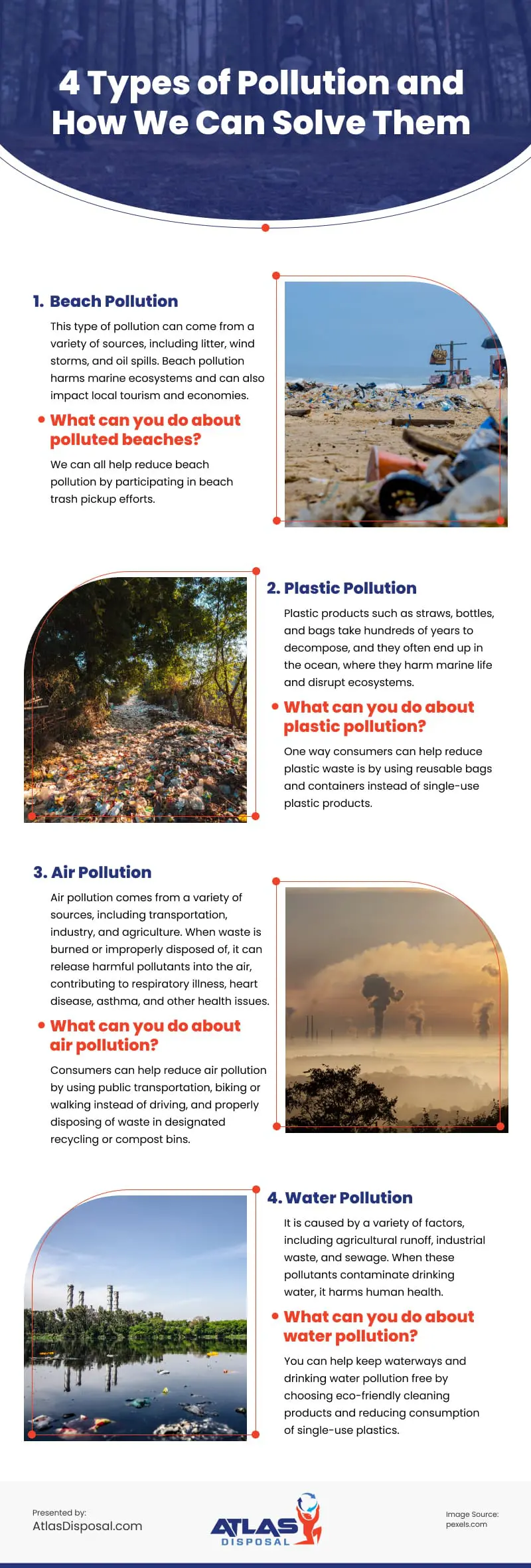
We neglected to be concerned about dumping rubbish into the sky for a long time. We now understand that CO2 and other molecules produced by humans permanently impact the environment. In essence, garbage from factories, airlines, and automobiles causes climate change. In light of all of this, it is evident that trash is the root cause of pollution, which affects everything from the water we drink to the air we breathe. What are some waste-related pollution types, and what can we do to prevent them?
1. Beach Pollution
Though it may seem particular, many people are too familiar with beach pollution. Litter, windstorms, and oil spills are just a few examples of the many sources of this kind of pollution. Beach pollution damages marine habitats and may harm regional businesses and tourism. We can all contribute to reducing beach pollution by participating in beach garbage collection operations. If you don’t live near a beach, you can still help safeguard these significant coastal areas by purchasing eco-friendly items and donating them to charities fighting beach pollution.
2. Plastic Pollution
Plastic pollution would be the queen if different types of pollution were chess pieces. The most prevalent kind of garbage is plastic. Straws, bottles, and bags made of plastic take hundreds of years to disintegrate and frequently end up in the water, harming marine life and upsetting ecosystems. Utilizing reusable bags and containers in place of single-use plastic products is one method that consumers may use to reduce plastic waste. Suppose enough individuals make these minor adjustments, such as carrying their own shopping bags to the store and using a refillable water bottle rather than purchasing bottled water. In that case, they build up to a measurable change.
3. Air Pollution
Transportation, industry, and agriculture are a few factors contributing to air pollution. The fact that anyone can cause air pollution is one of its difficulties. Since air mixes quickly, the consequences affect us all. When waste is burned or disposed of inappropriately, it can emit dangerous pollutants into the air, worsening asthma, heart disease, and other health conditions.
By taking public transportation, biking or walking instead of driving, and properly disposing of garbage in designated recycling or compost containers, consumers can reduce air pollution. Reduce the overall impact of waste on air quality by buying goods from businesses dedicated to sustainability and low-carbon production. The best course of action may be to speak to your local elected officials in favor of reducing air pollution.
4. Water Pollution
Like air and land pollution, people don’t just dump trash into rivers to cause water contamination. Many things, such as sewage, industrial waste, and runoff from agriculture, bring it on. Human health is harmed when these pollutants contaminate drinking water. In developing nations without adequate water filtering systems, we frequently consider water pollution a major problem. Even though this is a significant problem for developing countries, it is also a concern for wealthy nations. Millions of dollars are wasted each year by polluted water, which also endangers people’s livelihoods and worsens as aquifers dry up and agricultural techniques become more intensive.
By utilizing environmentally friendly cleaning supplies and limiting your use of single-use plastics, you can contribute to preserving clean drinking water and waterways. Making your own composting toilet is relatively easy and makes fantastic, fertile soil, so it’s grown increasingly popular lately.
source: https://atlasdisposal.com/blog/the-pollution-problem-and-what-we-can-do-about-it/
Comments
Download this infographic.
